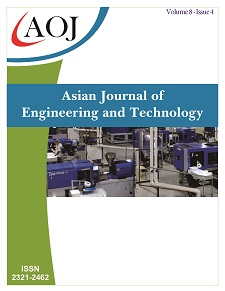Force Transducers Relative error of Zero
DOI:
https://doi.org/10.24203/ajet.v8i4.6407Keywords:
Force, Calibration, Relative zero error, ISO 376Abstract
This study represent the influence of relative zero error on force proving instruments classification. It is directed to compare the relative zero error resulted from the three loading scenarios applied during calibration of force proving instruments in increasing and decreasing scheme as per ISO 376:2011. It is conclude that the maximum relative zero error resulted after the first loading series at zero position. Two methods are recommended to be proposed as a unique method to calculate the maximum relative error of zero from the first and second loading series or from the preloading series
References
Seif. M. Osman, Ebtisam H. Hasan, H. M. El-Hakeem, R. M. Rashad, F. Kouta “Conceptual Design of Multi-Capacity Load Cell” Proceedings of 16th International Congress of Metrology 7-10 October 2013 Paris, France. DOI:10.1051/metrology/201203002
Dan Mihai Stefanescu, Alexandru Stefanescu.”Criteria for Choosing the Elastic Elements of Force Transducers” Proceedings of the 17th International conference IMEKO, pp. 134-140, Istanbul, Turkey, Sept.2006.
Seif. M. Osman, R.Kumme, H. M. El-Hakeem, F. Löffler, Ebtisam H. Hasan, R.M.Rashad, F. Kouta “Force Transducer with Different Capacities” Proceedings of XXI IMEKO World Congress Aug. 30 Sept. 4, 2015, Prague, Czech Republic
ISO 376:2011; “Metallic materials-Calibration of force proving instruments used for the verification of uniaxial testing machines”.
https://www.iso.org/standard/44661.html
ISO 376:2004; “Metallic materials-Calibration of force proving instruments used for the verification of uniaxial testing machines”.
https://www.iso.org/standard/44661.html
Wei Liang, Xiao-xiangYang, JinhuiYao “Rotation effects of force transducer on the output of the build-up system”, Measurement, Volume 138, May 2019, Pages 659-671, https://doi.org/10.1016/j.measurement.2019.01.071
Dae-ImKang, Chang-SunHong “Rotation effects of force transducers on the output of a build-up system” Measurement, Volume 14, Issue 2, December 1994, Pages 147-156, https://doi.org/10.1016/0263-2241(94)90023-X
TiepingWei, XiaoxiangYang, JinhuiYao, HangXu, “The influence of a balanced structure on the rotation effect of a build-up system” Measurement, Volume 61, February 2015, Pages 162-168, https://doi.org/10.1016/j.measurement.2014.10.043
El-sayed A. A., El-Hakeem H.M., Gloeckner B., Allgeier T. Performance Evaluation and Metrological Characteristics of a dead weight force Standard Machine with substitute load control system. Proceedings of IMEKO conference, 2002
Downloads
Published
Issue
Section
License
Copyright (c) 2020 Seifelnasr Osman

This work is licensed under a Creative Commons Attribution-NonCommercial 4.0 International License.
- Papers must be submitted on the understanding that they have not been published elsewhere (except in the form of an abstract or as part of a published lecture, review, or thesis) and are not currently under consideration by another journal published by any other publisher.
- It is also the authors responsibility to ensure that the articles emanating from a particular source are submitted with the necessary approval.
- The authors warrant that the paper is original and that he/she is the author of the paper, except for material that is clearly identified as to its original source, with permission notices from the copyright owners where required.
- The authors ensure that all the references carefully and they are accurate in the text as well as in the list of references (and vice versa).
- Authors retain copyright and grant the journal right of first publication with the work simultaneously licensed under a Attribution-NonCommercial 4.0 International that allows others to share the work with an acknowledgement of the work's authorship and initial publication in this journal.
- Authors are able to enter into separate, additional contractual arrangements for the non-exclusive distribution of the journal's published version of the work (e.g., post it to an institutional repository or publish it in a book), with an acknowledgement of its initial publication in this journal.
- Authors are permitted and encouraged to post their work online (e.g., in institutional repositories or on their website) prior to and during the submission process, as it can lead to productive exchanges, as well as earlier and greater citation of published work (See The Effect of Open Access).
- The journal/publisher is not responsible for subsequent uses of the work. It is the author's responsibility to bring an infringement action if so desired by the author.


